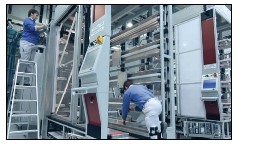
—
Kai Vogt, Director - International Business,
centrotherm photovoltaics AG
centrotherm photovoltaics AG is one of
the world's leading technology and
equipment provider for the photovoltaics
sector. In the 2010 financial year, the
group achieved revenue of €624.2
million.
Kai Vogt tells
Sandeep
Menezes that India has missed the bus
in semiconductor manufacturing and
can ill afford to do so for the solar PV
manufacturing.
What is centrotherm's future business strategy in India? How will centrotherm's foray
into India benefit the solar sector?
India is regarded as an important growth market for centrotherm photovoltaics. We
now have local presence by opening a subsidiary in India to support our existing and
prospect customers in getting them to be best in class with low production costs and
produce high quality solar cells. Our office in India will provide sales and support
services to our clients.
Our early customers in India manufacture c-Si cells with the highest efficiency in
India and compete with global players in quality. We are bringing the most
advanced solutions with German engineering and technology to drive down the cost
of solar PV electricity.

We are here in India to support and enable the National Solar Mission, one of the
objective is to take a global leadership role in solar manufacturing (across the value
chain) of leading edge solar technologies and target a 4-5 GW equivalent of
manufacturing capacity, including setting up of dedicated manufacturing capacities for
poly silicon material to make solar cells.
Tell us about some global projects wherein centrotherm's equipment, technology has
been utilized.
centrotherm photovoltaics brings with it more than 30 years of experience in serving the
PV industry as leading equipment and technology supplier. The company has enabled
and shown success especially in countries like China, Taiwan, Korea and others.
In the segment of silicon & Wafer centrotherm photovoltaics succeeded last year
the commissioning and production of first silicon at polysilicon factories in Taiwan, China and Europe, and the signing of an agreement to construct
a silicon factory in Qatar comprising an order volume of around
€150 million.

In the segment Solar Cell and Module centrotherm
photovoltaics AG has successfully transferred excellent
laboratory results to production operation at the Chinese
customer Dongfang Magi Solar in the first quarter 2011: an
average 18.5 percent solar cell efficiency was achieved by using
an upgrade package for selective emitter technology and
exceeded the current industrial average.
In the second part 2010 centrotherm photovoltaics has started
the first step of the large-scale solar cell production project at
Chinese state company Lu'an Group Corp. in Changzhi. The 60 mw
solar cell turnkey factory is based on state-of-the-art technology.
At the same time, the foundation stone was laid for additional
production lines to manufacture solar cells to a level of between
300 and 360 mw, which will be installed during the second
expansion stage. In overall terms, the customer plans to expand its
manufacturing capacity to one GW over the coming years. In
parallel, centrotherm SiTec GmbH, a one hundred percent
centrotherm photovoltaics AG subsidiary, is setting up production
systems at Lu'an Group for the manufacture of polysilicon with
annual production output in excess of 3,000 tonnes. centrotherm
photovoltaics is setting and supporting a new trend in
implementing the integrated factory concept by delivering
polysilicon production and solar cell manufacturing as a one-stop
solution to position their customers as cost leaders on the market.
 Do you foresee India evolving as a base for solar PV cells given that
it does not yet have established semi-conductor industry?
Do you foresee India evolving as a base for solar PV cells given that
it does not yet have established semi-conductor industry?
It is absolutely clear that India has to develop a base for solar PV
cells to fulfill the Solar Mission objectives. India has missed the bus
in semiconductor manufacturing and can ill afford to do so for the
solar PV manufacturing. The lack of semiconductor manufacturing
industry should motivate India to ensure that the nascent
manufacturing market for solar PV develops and provides the
energy security that the country needs. We wish for the first phase
of solar PV to be successful as it sets the tone for the mission
success. We believe the central and state governments are doing
their part and it is up to the industry to execute.
Solar energy generated from just 10 per cent of India's Thar desert,
can meet all of India's power needs. But solar as an energy option
is still under utilized in India. What is your view?
The abundant sunshine in India and growing energy needs makes
it imperative that we overcome challenges to make solar energy a
reality to meet a large share of the energy needs. It is clear that
there are enough fallow lands available in India to make this a
reality. However there are other challenges:
- Cost of funds in India as solar PV has a high upfront capital cost.
Understanding of the technology by banks to finance solar
projects
- Diesel subsidy masking the true cost of electricity in stand by
diesel generators. Some efforts have been made to rectify this
by Ministry of New & Renewable Energy by targeting solar power
usage in telecom towers for example.
 The solar mission has targeted installed capacity of 20,000 mw by
the end of XIII Five Year Plan in 2022. How feasible is this target?
Tell us about the role to be played by companies such as Moser
Baer in achieving this target?
The solar mission has targeted installed capacity of 20,000 mw by
the end of XIII Five Year Plan in 2022. How feasible is this target?
Tell us about the role to be played by companies such as Moser
Baer in achieving this target?
The 20GW target by 2022 has to be viewed in context of the energy
needs of India in 2022 and the fossil fuel availability. The policy
makers in India have no choice but to set ambitious targets and
drive the industry. A similar effort is underway in countries around
the world. Already there are reports of coal for the upcoming
thermal power plants being secured from mines in Australia and
Indonesia. The target for solar mission is definitely achievable if
the pace of innovation is kept up to reduce the price. This means the
technology developers like centrotherm continuing the pace of
innovation, manufacturers building scale to lower the cost,
installers that develop new applications and techniques while the
government facilitates the regulatory field.
Centre recently specified that only Indian components should be utilised in manufacturing solar photovoltaic modules to claim
subsidies under JNNSM. Any comment?
The regulation mandates that the c-Si modules for a solar power
plant should be manufactured in India this year and the c-Si cells
and modules should be manufactured in India. We are supportive
of the Government efforts to boost local manufacturing and
develop the value chain.
India's solar industry is projected to generate $3 billion in revenues
by 2013. Will this growth be mainly driven by domestic demand?
The solar mission target is for installation of 1.3GW by 2013
(including solar PV and solar thermal). The $3 billion revenue
projection is in sync with that domestic installation target.
 There are huge solar PV off-grid opportunities across India since
over 400 million people do not have access to grid connected
electricity. Comment.
There are huge solar PV off-grid opportunities across India since
over 400 million people do not have access to grid connected
electricity. Comment.
Solar PV off-grid enables remote villages and tribal sections to
get access to electricity. The upfront capital and cost of funds is
a deterrent for off grid opportunities. Our customer Tata BP
Solar has pioneered this in India by working closely with banks
and making it a viable option for many rural households. We
believe that with the government focus for inclusive growth and
making electricity available for rural, the off-grid opportunity will
develop further.
Critics argue solar industry can't survive without governmental
assistance. Comment.
The total cost of subsidies and environmental impact of fossil
fuel (coal and diesel) is not captured in their market price. The
pollution and health cost for usage of fossil fuel is bourn by the
country. It is imperative to invest in the future development of
new and renewable energy sources.
The cost of fossil fuel energy will continue to increase as
these resources turn scarce. On the other hand, solar
PV is established as a technology that has been successfully
reducing the cost of power as the industry grows. Already
the cost of solar PV power has reached the grid parity
levels (cost of conventional energy sources) in some
markets and more markets will open up as the cost continues
to come down.